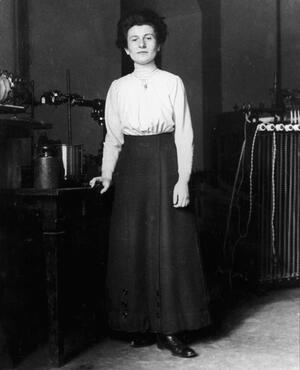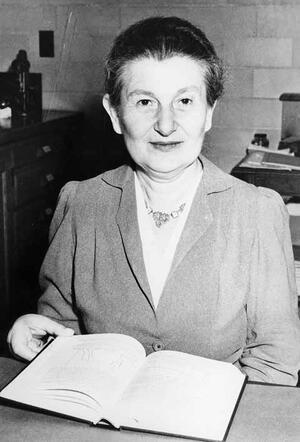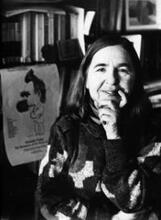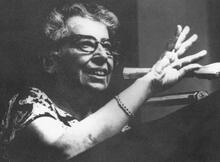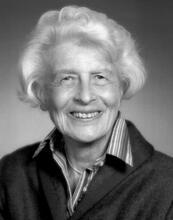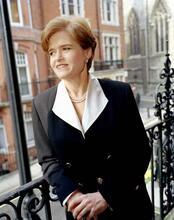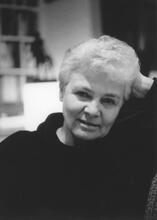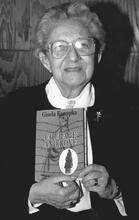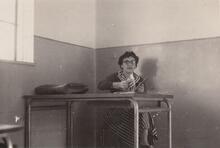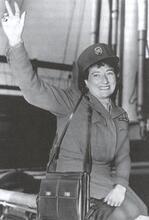Hedwig Kohn
Hedwig Kohn was one of the early woman pioneers in physics, contributing over her lifetime to the field of flame spectroscopy. Kohn obtained her doctorate, taught, and researched at the university in Breslau before her dismissal in 1933. With help from her colleague Rudolf Ladenburg, the American Association of University Women, and several women’s colleges in the United States, Kohn obtained a visa and fled Germany in 1940. She became a highly regarded professor at Wellesley College, where she set up a research laboratory. After retiring in 1952, she pursued independent research at Duke University for twelve more years in the field of flame spectroscopy, measuring absorption features of atomic species in flames. This research experienced a renaissance in the 1960s in the form of combustion science and plasma physics.
Hedwig Kohn was one of the early women pioneers in physics, not only in Germany. She was born on April 5, 1887, in Breslau (today Wrocław, Poland), the daughter of Georg Kohn (1850–1932), a wholesale merchant of fine cloth, and Helene Hancke (1859–1926), a member of a well-established Breslau family. Hedwig entered the university there as an auditor in 1907, a year before women were officially allowed to matriculate, and obtained a doctorate in physics in 1913.
Kohn’s advisor was Otto Lummer, famous for precision radiation measurements that contributed to the formulation of Planck’s radiation law, who appointed her to the position of Assistant in 1914. During World War I she took on a large share of the teaching and also the advising of doctoral students, in spite of her youth, even receiving a medal for this service after the war. She remained in Breslau and, after years of teaching and research, was given the Habilitation at the university there in 1930. By 1940 she had guided the work of eight doctoral students.
In 1933, Kohn was removed from her university position because she was Jewish. Research contracts were found to tide her over, while she occupied a small back room in the Physics Institute where students and colleagues nevertheless managed to find her. In 1935, American financing allowed her a three-month stay in the Licht-Klimatisches Observatorium in Arosa, Switzerland, measuring ultra-violet light intensity from the sun. However, no permanent job developed from this visit. After Kristallnacht (November 9, 1938), it was clear that emigration was urgently necessary, but how? The rules of the game were clear: Without a job offer somewhere, she could not escape from Nazi Germany.
Visa Troubles
Although a good and respected physicist, she was neither internationally famous nor a professor. The hurdles to her obtaining a job offer in America or elsewhere were clearly defined: an acute lack of university positions in Western countries, due to the Great Depression; being foreign, even German; not being prominent or personally known abroad; being no longer young and—being a woman. In some cases, antisemitism may have been a further, usually unspoken and thus undocumented, factor. After 1938, to obtain a visa for the U.S. to work in a teaching position, the applicant must have been employed in a teaching position within the last two years for a duration of at least two years. Since she had been barred from teaching since 1933, such a visa was unattainable for her. Fortunately, this restriction was dropped in 1940. Even so, employment for two years had to be guaranteed.
Efforts to help Hedwig Kohn’s immigration were initiated in November 1938 by Rudolf Ladenburg (1882–1952). As a young lecturer in Breslau, Ladenburg had directed Kohn’s doctoral research, although officially she was Otto Lummer’s student. Ladenburg was now a highly respected physicist at Princeton University. Stimulated by Ladenburg, the International Federation of University Women (IFUW) and the Society for the Protection of Science and Learning (SPSL) in London were able to mediate a job for Hedwig Kohn at the University of Aberdeen for the winter of 1939.
Emigration to the United States
Notice of the granting of the visa reached Kohn in the middle of August 1939, but before she could depart, war had broken out. England immediately instituted a flat visa cancellation for all “enemy aliens.” There followed an exchange of at least 70 letters involving Hedwig Kohn, Rudolf Ladenburg, Max Born, Lise Meitner and Hertha Sponer, representatives of the American Association of University Women (AAUW), the Swedish and British branches of the IFUW, and, crucially, several women’s colleges and one university in the U.S. The tediously achieved result was, finally, offers of three consecutive one-year positions, each at a women’s college: the Women’s College of the University of North Carolina, Sweetbriar Collegein Virginia, and Wellesley College in Massachusetts. These sufficed for the promise of a visa for the U.S., which in turn led to a visa to go to Sweden in July 1940, which she did immediately. The physicists and the women saved her life. Her only brother, Kurt (b. 1885), a judge, was deported to Kovno in November 1941 and murdered.
The remaining hurdle was to get from Stockholm to Greensboro, North Carolina, in the middle of a war, with the Atlantic a battleground. Kohn left Stockholm on October 12, 1940, and traveled on the Trans-Siberian Railway to Vladivostok, reaching the U.S. two months later, seriously ill. By January 1941, after a recuperative stay with James Franck in Chicago and then with Hertha Sponer in Durham, North Carolina, she was able to report for work at the Women’s College in Greensboro, North Carolina.
Hedwig Kohn spent a year and a half in Greensboro and threw herself into the new environment and new tasks with a calm and persistent optimism and good humor. She went on to the prearranged position at Wellesley, where she became a highly regarded professor, won a college research award, and stayed until her retirement in 1952. While at Wellesley, she set up a modest research laboratory for flame spectroscopy, but though it served for introducing students to research, no publications came from this period. In 1952 she was awarded a pension and the title of professor emerita by the government of the Federal Republic of Germany.
Independent Research at Duke & Legacy
After retirement, Kohn was able to pursue independent research as a Research Associate at Duke University for twelve more years, until shortly before her death in 1964. During this time, she directed the research of two Ph.D. students and recruited two postdoctoral fellows to work with her on flame spectroscopy, measuring absorption features and concentrations of mostly atomic species in flames. This research, a continuation of what she had done from 1912 to 1933, experienced a renaissance in the 1960s in the framework of combustion science and plasma physics.
In both the earlier and later periods of her work, Kohn worked in the field of quantitative measurement of the intensity of radiation and contributed to atomic and molecular spectroscopy, mostly in work involving quantitative measurements of luminosity or temperature. She wrote several chapters, amounting to over 200 pages, in a leading physics textbook, Mueller-Pouillets Lehrbuch der Physik, 1929. These became the basis of her Habilitation. The paper reporting her doctoral work was still being cited through the 1970s. Her earlier work resulted in fourteen respected publications and one patent. Seven publications resulted from the later research period at Duke. Her textbook contributions on radiometry, the measurement of the intensity of visible light radiation, and the temperature of flames remained the standard introduction to the field until well into the 1960s.
Selected Works by Hedwig Kohn
Mueller-Pouillets Lehrbuch der Physik. (II. Auflage), unter Mitwirkung zahlreicher Gelehrter herausgegeben von A. Eucken, O. Lummer (+), E. Waetzmann. In fuenf Baenden: I. Mechanik und Akustik; II. Lehre von der strahlenden Energie (Optik); III. Waermelehre; IV. Elektizitaet und Magnetismus; V. Physik der Erde und des Kosmos (einschl. Relativitaetstheorie). Braunschweig: 1925-1929.
Band II, Zweite Hälfte, Erster Teil (Volume II, 2. half, 1. part), volume editor Karl W. Meissner: 1929. In Band II: Chapter 22, “Photometrie.” 1104–1320; Chapter 25, “Temperaturbestimmung auf Grund von Strahlungsmessungen.” 1428–1469; Chapter 26, “Ziele und Grenzen der Lichttechnik.” 1470–1482.
Winnewisser, Brenda P. “The Emigration of Hedwig Kohn, Physicist, 1940.” Österreichische Gesellschaft für Wissenschaftgeschichte. (1998): 41–58.
Winnewisser, Brenda P. “Hedwig Kohn —eine Physikerin des zwanzigsten Jahrhunderts.” Physik Journal. (2003): November, 51–57.
Archives
Additional material on Hedwig Kohn can be found in the archives of:
University of Wrocław.
American Association of University Women.
Society for the Preservation of Science and Learning, Bodleian Library, Oxford.
University of North Carolina, Chapel Hill and Greensboro, North Carolina.
Lise Meitner Collection in the Churchill Archives Center, Churchill College, Cambridge.
Wellesley College; the Berlin Office of Restitution (Wiedergutmachungsamt, Berlin).

